Edison, NJ-based V-COMM’s expertise in cellular DAS keeps people in touch, both indoors and out
by Susan Bloom, NJ.com
According to a study by reviews.org, the average American checks their cell phone several hundred times per day — once every four minutes! – and relies on their phone and other electronic devices for everything from making personal or business calls to accessing social media, playing games, using apps, texting, connecting to e-mail, and more. So it’s extremely aggravating when poor signal strength inside a building impairs one’s ability to communicate or connect.
“Everyone has a smart phone with signal bars on it and has experienced the frustration of being unable to place a call, get information on the internet, or have a call drop inside a building,” shared Dominic Villecco, Founder and President of Edison, NJ-based V-COMM, a leading provider of integrated engineering services for the wireless and public safety industries since 1995. “Building owners increasingly come to us looking for ways to address this issue and ensure their occupants of connectivity inside their building.”
According to Villecco, much of the issue surrounding poor signal strength inside buildings stems from the fact that many of the modern and energy-efficient building materials and practices used to keep energy from leaking out – e.g., low-e glass, Leadership in Energy and Environmental Design (LEED) construction, etc. — can end up preventing radio signals from getting in.
In addition, “over time, cellular carriers often switch to new frequencies/channels that either aren’t optimized for the building, get overloaded, or don’t work well, which causes service holes to open up inside the building,” Villecco said.
That’s where V-COMM’s expertise in distributed antenna systems, or DAS, comes into play.
Ensuring Effectiveness, Reliability, and Resilience
“DAS is essentially a booster that helps ensure the same service inside that’s outside,” Villecco explained. “It may involve the use of a pickup antennae to pick up the outside signal, or else carriers can bring in a signal source and turn it into its own mini network distributed throughout the building. But thanks to a combination of components including amplifiers, coaxial cable, antennas, ethernet cable, and fiber optic cable, which is ideal for long runs because it achieves less signal loss/voltage drop over distances and enables us to transport signals to end destinations at proper levels,” he said, “DAS helps us secure and distribute the required signal throughout the entire square footage.”
Villecco noted that the installation of DAS involves the expert use of both amplification and filtering. “Through amplification, we take an external antenna that picks up signal, bring it inside the building, and boost it because building materials shield signals from coming in,” he said. “Filtering gets applied for so-called ‘near-far’ problems, which occur if one carrier operates service near the building, another is too far, and there’s subsequently too much signal coming in from one carrier and not enough from others; in these situations, filtering helps us balance the signal so that we can use all available carriers,” Villecco said.
In a complex market that features as many as a dozen different system architectures and multiple vendors with various equipment and specifications, Villecco said that it’s critical to work with a knowledgeable provider that understands DAS networks and can ensure the effectiveness, reliability, and resilience of these systems. “At V-COMM, we do design work, taking building plans at the ground-up stage and determining how to produce DAS systems scaled to those plans,” he said, noting that his team of specialists also offers full design-build services, required equipment, and monitoring and maintenance services once the system is operational. “Carriers change their networks over time, which can impact the existing DAS, so monitoring and maintenance are important to ensure that the system remains tuned up and optimized for that building,” he said. “It’s important to work with qualified, certified professionals, not just providers with limited understanding who apply off-the-shelf systems to a client’s unique application.”
While it enables building occupants to check e-mails and interface with the internet from their phones, Villecco noted that a properly-applied DAS also contributes to public safety and emergency response because people rely on their mobile devices during emergencies.
“Because poor connectivity can affect any building interior, especially newer buildings and even those located by a cell tower,” Villecco said, “new construction projects are increasingly incorporating in-building DAS systems up front, so it’s important to find a provider who understands the technology and knows how to make all carriers work well inside the building. Based on our experience in the industry and sophisticated level of engineering capability, we can identify a building’s exact problem and fix it in the most affordable and sustainable way for the client. It requires proper design to meet expectations today while being able to be modified in the future when carriers change their networks,” he said, “and V-COMM can make it happen.”






